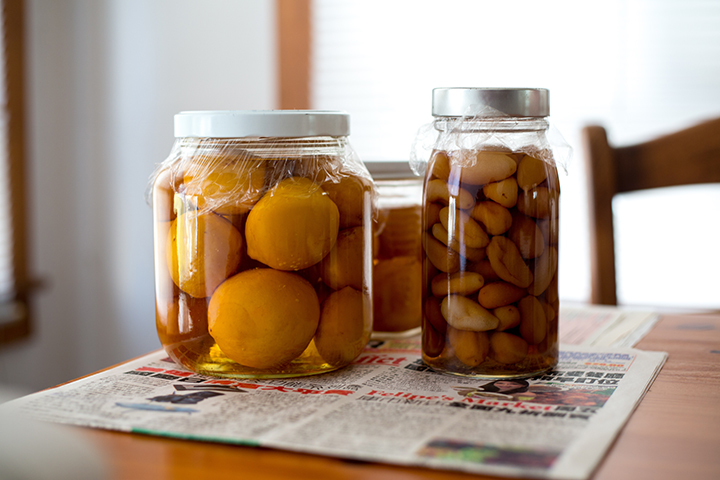| Issue #66 • November/December, 2000 |
Like many who were born shortly after World War II, I grew up in a family with a solidly “city” lifestyle. My mother saw canning as drudgery. For her, commercially prepared food, especially TV dinners, were the only way to go. But commercially prepared products can come with questionable chemicals, among other problems. Today, home canning is a simple way to take greater control of your health and well-being, and of your budget.

When I moved to a remote, rural area with my husband, an enthusiastic home canner, I quickly saw the value of preserving food ourselves. As a result, I trained as a Master Food Preserver in a program run by the United States Department of Agriculture (USDA) through my County Extension office. I went on to teach food preservation skills classes.
From these experiences, as well as my own food-storage background, I know that there are some details that no one else ever seems to tell you.
Updating your recipes
Articles on canning typically recommend that you get “a good canning book” with comprehensive processing and safety guidelines. That’s leaving way too much to chance, as I found out in one of my first class sessions.
One lady regularly used her grandma’s high school, domestic-science textbook, copyright 1918. Another had been using USDA pamphlets dating from the 1940s. Several of my students had the highly-recommended book Putting Food By, first published in 1973. Old copies still circulate through rummage sales and thrift stores.
All of these sources were reputable in their day, and everyone wants to know, “What’s wrong with them now?”
A lot of genetic engineering of fruits and vegetables has gone on since then, along with a lot of research and development in preservation techniques. Together, these developments have made food preservation more precise and much safer than it was years ago.
For example, in the 26 years since Putting Food By first came out, science has produced tomatoes with improved disease and pest resistance. They’re also much lower in acid than the ones grandma grew. That means they must be processed differently than grandma did hers.
Anyone for canned eggs?
Ever heard of an old-time was of preserving eggs called waterglassing? It’s a method that won’t win many conterts today, but for someone who needs to reduce their dependency on refrigeration, it might be worth a try.
Hens naturally lay more eggs in the spring. There are ways to even out the cydle, but people who keep hens will still have spells of heavy or light production.
Where refrigeration was either unavailable or too expensive, old-timers often kept their eggs and milk fresh longer by loading them into a bucket and lowering them into a deep well. (They also developed egg-free recipes for those times when they simply had to do without.)
Waterglassing was also fairly common, and I always wondered how it was done. When I finally found directions for the process, I realized why it had fallen so thouroughly out of favor. Beyond storing the eggs in a cool dry place, waterglassing calls for them to be immersed in a slimy, unappetizing liquid.
Waterglass is a sodium silicate solution, obtained from a druggist. One pint of waterglass is mixed with 9 to 10 pints of boiled, cooled water. The solution is then poured into a scalded storage crock (ora 5-gallon bucket), and the eggs are immersed in it. The slimy solution seals the pourous eggshell against air and moisture and thus retards spoilage.
Keep the fluid in the crock at least 2 inches above the eggs to allow for evaporation. Add more boiled, cooled water to maintain that level. Keep the crock tightly sealed and in a cool place. The solution isn’t poisonous, but you have to be careful to rinse the eggs well before you use them.
The most accurate, up-to-date, and dependable guidelines are in the current bulletins put out by the USDA, available at a small cost from your local county extension office, or from the Consumer Information Center (see resources sidebar). Read these pamphlets carefully, and follow their instructions, regardless of what your recipe may say.
If you compare the processing requirements in these new pamphlets with the current versions of classics such as the Ball Blue Book, you should find that they are identical. If not, it’s a good idea to cross out the old instructions in your recipe and write in the updated ones, such as processing time, or canner pressure. This way you can still use your heirloom recipes safely.
A final note of caution: check yearly with your county extension office to see if any of your pamphlets have been updated. If so, they will have new pamphlet numbers. It’s always best to work from the most recent information.
Maintaining your pressure canner
People who use pressure canners often think they last a lifetime without maintenance. No, no, no! Several features of pressure canners need to be checked regularly or replaced to keep the canner in safe working condition.
Gaskets: Most pressure canners use a rubber gasket or sealing ring in the lid. These rings will dry out, crack, stretch, harden, or become damaged with time and use. Steam-borne food particles can work their way around the gasket. When any of these things happen, the canner will not maintain pressure properly. Remove and carefully inspect the gasket and replace it if necessary. You can often find replacements at hardware stores or from the manufacturer. Never use a pressure canner that has a bad gasket.
Dial Gauges: You should also test your dial gauges for accuracy once a year. Like other mechanical devices these gauges can malfunction. They can also become inaccurate from the hazards of use, such as being accidentally banged against something, or storage, such as exposure to extreme heat or cold during the off-season. Ask your local extension office how you can have your gauge checked.
Safety Plugs: Pressure canners have safety plugs to prevent explosions by releasing the pressure if it becomes dangerously high. They may be metal, designed to melt under extreme pressure, or when the canner boils dry; or they may be composition rubber, which are blown out by high pressure. Either can become damaged in the same ways as a gasket or gauge. Replacements will probably have to come from the manufacturer.
Vent Port: Finally, a pressure canner will have a vent port, used with either a weighted gauge or petcock, which the user can control to release or hold pressure in the canner. These can become clogged with particles of food. Clean them by drawing a string through the opening.
Anyone who uses a pressure canner should always keep three things on hand: replacement parts, a manufacturer’s guide for their specific model, and the USDA pamphlet on pressure canner maintenance (see resources sidebar). Don’t wait until something breaks. Check your canner now and contact its manufacturer. Your county extension office or local library should have the manufacturer’s address or toll-free phone number.
Disposing of spoiled food
Every home canner will occasionally have jars that spoil on the shelf. The need for safety here can’t be overemphasized. The organisms that spoil canned food are uniformly poisonous to humans, especially in the quantity present in a bad jar of canned food.
The most potent spoilage organism in low-acid foods is botulism, which produces a powerful neurotoxin that will shut down your nervous system. Low-acid foods that have spoiled should be disposed of with the utmost caution because he botulism toxin can be absorbed through the skin. I’m going to detail the most cautious handling methods I know.
First, when you find a spoiled jar, put it down immediately and wash your hands. Prepare a sanitizing solution of ¾ tsp. bleach to 1 cup of water, preferably in a spray bottle. Sanitize your hands with this solution and then put on rubber gloves. Now you can dispose of the spoiled food one of these three ways:
Resources
The Ball Blue Book,The Ball Home Canners Catalog, and home canning equipment and supplies are available from:
Alltrista Corporation
P.O. Box 2005
Muncie, IN 47307-0005
1-800-859-2255
www.homecanning.com
The Kerr Kitchen Cookbook, a home canning and freezing guide, is $3.50 plus 50 cents S&H, from:
Kerr Glass Mfg. Corp.
P.O. Box 76961
Los Angeles, CA 90076
A home canning and freezing guide is one of many federal publications available from:
Consumer Information Catalog
Pueblo, CO 81002
1-888-878-3256
www.pueblo.gsa.gov/cicform.htm
Bulletins available through your county extension office may be specifically revised for your geographic area. Look for ones on caring for pressure canners, canning tomatoes, vegetables, seafood, and fruits.
For miscellaneous questions about food preservation, check your phone book for your local County Extension office. Find out who your extension agent is, if they have any master food preservers registered, and what USDA pamphlets they stock. In some states smaller counties share agents. If this is the case with you, find the nearest county that has a staffed office, their office hours, and names of volunteers you can call for advice during off-hours.
If you run into trouble on a hot Sunday afternoon, the expense of a long-distance phone call is nothing compared to the loss of a batch of food or the risk of food poisoning.
Disposal method 1: Put the jar in a heavy plastic bag, twist the bag shut, turn the bag inside-out to cover the jar with a second layer of plastic, and securely seal it shut. Then send the whole shebang off to the local dump. Use the sanitizing solution and a paper towel to clean up any dribbles or splatters, including on the shelf where the jar was stored and on the sides of the surrounding jars. Then wash and sanitize your rubber gloves while still wearing them.
Using this method, you’ll lose your canning jar, but this is often the best way to handle the situation.
Disposal method 2: Put the jar in a plastic bag, and take it to the bathroom. Carefully open the jar over the toilet and pour its contents into the bowl, flushing several times. Put the jar back into the bag, and carefully clean both your rubber gloves with your sanitizing solution. Use the same solution to clean the toilet, which may have gotten splattered with canning liquid. Then take the bag with its jar and soak it in more sanitizing solution (a ratio of 1/8 cup of bleach to each gallon of water). After 15 minutes or so, drain and dispose of the bag, and wash the jar.
Disposal method 3: Put the jar in a plastic bag and take it outside. Dig a deep hole (2 feet or more) and bury the contents. Clean the jar and your gloves as described above.
This last method has at least two major drawbacks. First, conditions may exist such that you may not be able to get outside and dig the hole right away (such as with frozen ground). Second, a determined animal may still be able to dig up your buried jar. If the animal gets any of the spoiled food on its fur the botulism toxins can be easily transferred to other surfaces. In the case of a pet, this is a real danger to humans who pet it. For this reason, spoiled canned food should never be composted or put into a worm box, either.
This would be a good moment to discuss a common attitude about food preservation: “My grandmother (or whoever) always did it this way, and she never had any spoilage. Why should I do it any differently?”
Whenever I’m asked this question, I reply that, aside from the new, low-acid foods, I know of three possible reasons why you shouldn’t do it the way Grandma did:
The first is that Grandma probably didn’t live in a house that was well insulated and centrally heated. The warmest spot in her house was near the wood stove, and the farther away from the stove you got, the colder it was. Her storage space (a pantry, basement, or root cellar) was probably in a cold area that stayed just above freezing during the winter. Grandma’s canned goods were, in effect, refrigerated, and that contributed mightily to their keeping value.
A second possible reason is that, prior to World War II, people were less likely to amass canned food reserves in excess of a year’s needs. The more primitive, labor-intensive gardening methods, as well as the lack of well-paid, year-round employment, meant that most people did not have their home-canned food last them all the way until the next harvest.
A third, less pleasant reason is that because botulism is odorless, colorless, and tasteless, many people probably succumbed to it without anyone knowing what had made them sick. Today we often take for granted the technology that can pinpoint the cause of an illness. Even a generation ago, food poisoning often went undiagnosed, or was mistaken for something else.
Canning is a fine home craft. Keeping a balanced assortment of home-preserved foods in your pantry gives you a wonderful sense of security and accomplishment. Best wishes to everyone who gives it a try.















Love this